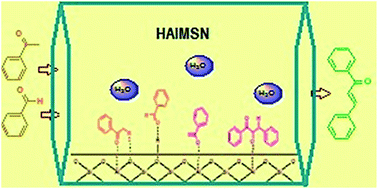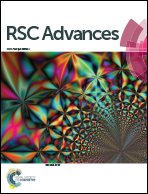Catalyzed Claisen–Schmidt reaction by protonated aluminate mesoporous silica nanomaterial focused on the (E)-chalcone synthesis as a biologically active compound
Abstract
The mesoporous silica structure (MSN) was synthesized using the sol–gel method followed by aluminum grafting and protonation and was then denoted as HAlMSN (Si/Al = 18.9). N2 physisorption confirmed the mesoporous structure with a pore diameter of 3.38 nm. 27Al NMR showed the presence of framework and extra-framework aluminum structures, which led to the formation of strong Lewis and Brønsted acidic sites. HAlMSN catalyzed the synthesis of (E)-chalcones through the Claisen–Schmidt reaction. Chalcone derivatives have been applied as biologically active compounds with anti-cancer, anti-inflammatory and diuretic pharmacological activities. The products were obtained via reactions on the protonic acid sites of HAlMSN. The significant advantages of this reaction are high yield, easy work up, short reaction time and also compatibility with various organic solvents. The products were obtained in an excellent conversion of 97% at 298 K. The results show that the electron donating substituents exhibit higher conversion in comparison to electron withdrawing substituents. The stability of the catalyst was investigated by reusing it five times for (E)-chalcone production and there was only a slight decrease in its catalytic activity. The highest product of (E)-chalcone was observed with a 1 : 2 molar ratio of benzaldehyde/acetophenone. A comparative study in chalcone synthesis using the heterogeneous catalysts demonstrated that HAlMSN has a significantly high activity at low temperature.


 Please wait while we load your content...
Please wait while we load your content...